|
Posted in category "Faith"
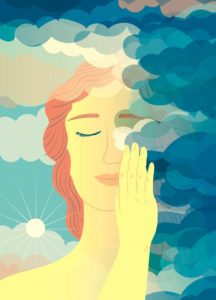 Image by Federica Bordoni I went through the entire history of the Conference for Catholic Lesbians (1982-1996) in preparation for this article. In the many letters, notes, articles and comments I read, all the women, regardless of where they were on the spectrum of being Catholic and lesbian, said the same thing: it is very important for me to be who I am. I need to discover all of who I am and would like to do this within a community where I feel safe and understood. I want to be with others where I will feel supported and affirmed in my spiritual and sexual identity. And most of all, I would like to be heard and respected as I talk or pray from the reality of my life.
Susanne S. wrote an op-ed piece for her local paper called, “At Peace with Faith, Sexuality,” For those of us who identify as Catholic and lesbian, it elegantly, and very simply and clearly articulates how we have reconciled what appears on the surface to be a contradiction in terms.
“When I was growing up,” she writes, “I had two passions: one was God, the second was women. Though I have gone through a lot of soul searching with both, neither of those things has changed. I always felt a deep reverence and comfort in the church, and most specifically the Catholic Church. Two years ago, I converted to the Catholic faith, something I had wanted to do all my life. Fortunately, I found a wonderful parish to do this in.
Two years ago, in June, I rediscovered my true sexuality. My sexuality has been a little less easily professed than my faith in God, since, of course, there are so many attitudes that work to repress it. However, through this blessing, I realize life is not worth living unless I can include this part of myself, no more than it is worth living if I cannot profess my faith. All the wonderful feelings I had left behind, along with my ability to write poems, came back to me. I felt whole again. Even without a significant relationship on the horizon, my life has continued to become so much brighter.
To many people my being so intensely Catholic and lesbian at the same time may seem hypocritical. After all, doesn’t the Catholic Church condemn lesbianism and homosexuality in general? And to many feminists and lesbians, Catholicism represents the height of the patriarchy. Yet for me there is no conflict of interest. I recognize the church as an imperfect, human interpretation of Christ’s perfect teachings. I do not believe every word in the Bible is true, or that our pope speaks for God. What I do believe is that God in His/Her infinite wisdom and compassion can bring forth inspiration in spite of prejudice.
The Catholic faith speaks to me, not because it is accurate in hierarchy or rule, but because it feels accurate to me in feeling and in spirit. I also know, unlike many women who are not lesbian and fear the idea of lesbianism, that love as a lesbian is as Godly as heterosexual love is. My feelings are an experience of joy that matches the joy I feel when I watch a priest consecrate the host or present us with a newly baptized child.
I am sorry that there is so much fear and cynicism in the world that some straight people look at my lesbianism as sad and misguided (or worse), and some lesbians look at my love for the Catholic Church as naïve or anti-woman. I hope one day there will be more people who can see the ability to marry their faith with their sexuality. I thank God for both of those parts of me.”
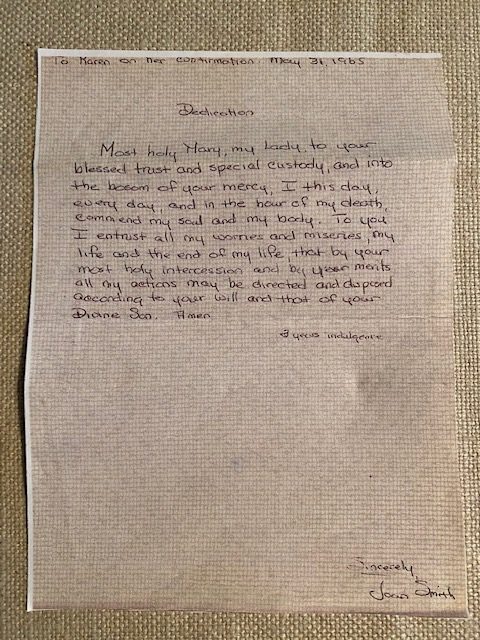 Joan Smith’s gift note Where does Faith begin? Mine began with a gift. May is typically the month for confirmations, and every May at Pentecost I remember my own, at St. Paul’s in Princeton, NJ. As we were getting ready for church, my sponsor came to the house. Unexpectedly, she brought another woman with her—a woman she introduced as her roommate. I hope I was friendly when we met, I was nervous and numb, and afraid Bishop Ahr would ask me a question I couldn’t answer. Too many times I went outside to play baseball or shoot hoops instead of sitting in the kitchen memorizing my confirmation questions.
My sponsor’s friend was named Joan. She said she wanted to come and meet me. She had heard a lot about me from my sponsor, and she wanted to give me a gift on the occasion of my confirmation. It was her own statue of the Blessed Mother, given to her many years before. The note that accompanied her gift read:
To Karen on her confirmation, May 31, 1965
Most Holy Mary, my Lady, to your blessed trust and special custody, and into the bosom of your mercy, I this day, every day, and in the hour of my death, commend my soul and my body. To you I entrust all my worries and miseries, my life and the end of my life, that by your most holy intercession and by your merits all my actions may be directed and disposed according to your will and that of your Divine Son. Amen
The bottom of the note was signed, “Sincerely, Joan S-“
I never saw her again, or heard from her, or heard of her. I did not know who she was, or what her relationship was to my sponsor, although I suspect I do now. My sponsor, parents and I went off to St. Paul’s for the ceremony. At the altar rail, my sponsor gave my shoulder a reassuring squeeze as the bishop approached. I stopped being nervous. Like a ghostly visitation that replays itself every May anniversary, I see a tall woman with short brown hair smile warmly at a shy and nervous 12-year-old in a white robe and red cap. She entrusts her with a precious gift, one she hopes will protect and comfort her always.
How is Faith lost? When trust is lost. In an article that I wrote for CCL’s newsletter, “Images,” I asked: “what can we do if we are not reaching you?” I was touched by several of the responses I received. One letter began:
“When you wrote, “If we are not reaching you . . .the memories of the great bond, the exhilarating feeling of the fall [conference] of ’88, all make me want to reach out to you and the women who helped make it possible with an embrace. ‘Cause you all filled a great void in me at that time. But I have a personal problem to deal with now. To a question of faith, the need for it, the lack of it, the search for it. My faith has been going down steadily for a long time now, until I can come to the point of saying: I am not a Catholic anymore, I don’t believe in the Catholic church, I don’t care for what it represents, and I don’t care to change it because it should be replaced. I even feel that the women who are trying to be part of it, of having a voice there, should reconsider being part of a religion in the name of which millions of human beings have lost their lives (remember the Inquisition, the Holocaust). And yet last February, when I last got together with a CCL group I felt good. But it was the bonding with the women, not Christianity. I have met a woman with whom I have been going for about 6 weeks now and she is a Buddhist. I am exploring her faith, her religion. I have to do now you may ask, Quo Vadis Anno? Ex-nun, ex-cab driver, ex-actress, now future monk? But it is not that bad. Don’t be surprised to find a check in the mail one day. Not as a renewal, but as a sign of support. Because I care for the women of CCL.
How is faith renewed? By unexpected ways. Another woman responded in this way:
“I decided to write a note with my new membership check & tell you about me and why I joined you. I lost my life partner of 17 years, Laurie on April -, 198- to ovarian cancer. She and I had met as Little Falls Franciscans and lived together after we left the religious community. We remained closeted in our work places but built friendship (including many ex-nuns) & family support throughout those 17 years together. When Laurie was dying, last Feb. she wrote her funeral liturgy & there was no doubt that it would be a Catholic/Franciscan ceremony. She incorporated religious songs she loved, wrote her petitions wherein I was proudly recognized as her life partner, had Offertory gifts brought up including our ring, symbolizing our life together & gave instructions on her homily, making sure that I was recognized and a part of it. The church held 400-500 of our families (hers & mine), friends & co-workers who flew in from 8 states. Laurie used the Catholic ritual of the Mass to stay farewell to us and give our lives together respect & honor. I share this with you because if you had heard Laurie & me discuss the Catholic Church throughout the years you would have heard criticism, disgust, sarcasm & hurt over our unacceptance as lesbians & our second class status as women. We talked often of a church we wanted to support & grow in but for that growth we began to look elsewhere. Now I am grateful to the Church for the gift it has given me through its ritual & music, which Laurie used to say good-bye & which she transformed for us as a final tribute to all that she loved. It – the Church – came through for us in the end. My best wishes to you as you continue to publish issues that need to be dealt with, as you encourage community & foster individual spiritual-human growth.”
For many decades my faith as flickered as a tiny candle in a dark cold night. I could never understand why it did not go out, but it never did. One time on retreat, the woman who was my spiritual director asked me how I could call myself “Catholic” when I never went to church or received communion. I can’t recall my answer, but it was probably something like I couldn’t stand the church, but I felt connected to experiences and values growing up and at school. But, her comment bothered me, because some part of it rang true.
Some years after that comment, acknowledging there was a place inside of me that was empty and lonesome, my life partner, Lori (now my wife) and I began attending our neighborhood church in Bay Ridge, Brooklyn. We registered as a “Family.” As such, we received a box of weekly donation envelopes with both our names on it. Our good friend, Sr. Jeannine Gramick of New Ways Ministry, used our comment – “You know you’ve really made it when both names on are the envelope” in her film, “In Good Conscience.” We thought it was quite funny, but it was also quite an acknowledgement.
After some weeks of attending Mass regularly, we volunteered to help out on the social justice committee, and sold Fair Trade coffee after Mass. We made a lot of good friends, and got to know people and they got to know us. Participation in the weekly liturgy, the good community, volunteering with others, the works of charity, and being reminded of other needs besides my own, helped me to return and belong more fully to my faith.
I still and will always have trouble with the sexist language and the way some bishops and church officials pound away over issues like gay marriage. But, in our church, we both have a place. Doubt and Discouragement are my ever-present companions in the pew every Saturday at 4 o’clock Mass, but they have to move over to make room for Hope and Faith.
At the 1982 conference at Kirkridge, one of the workshop speakers, Dr. Lorna Hochstein, talked about our relationship with God. She asked us to reflect on the ways in which our relationships with ourselves, with others and with God are affected by the degree to which we acknowledge to ourselves and others that God created us lesbian. Because of that fact we live, love and experience God and the world in a special, particular and complementary way.
Dr. Hochstein told participants that she was not proposing that they disclose their sexual orientation regardless of consequences. But she repeatedly pointed out that invisibility and silence in themselves have consequences: “There are consequences in our relationships with others and thus with God when we choose to keep silent—consequences which affect our understanding of ourselves and the world’s understanding of us. But more important, consequences which affect our understanding and the world’s understanding of God.”
My own relationship with God had been shriveled and bitter for many years. I blamed God for my alcoholism with its horrible pain and loneliness. I wouldn’t set foot in a church I was so angry at God. I was not alone in my feeling of anger: “For the past several months,” a woman wrote, “my personal life has been rather chaotic. And unfortunately, one of the results of that chaos is a great deal of anger directed at God. Despite having physically left the Church, several years ago, that is a new emotion for me. I think the only way I am going to get over that anger is to deal with it directly, a kind of one on one with God. I think all I’m capable of right now is going back to Mass and working through the anger.” We were both estranged from God. The writer’s goal was a one-on-one encounter, but mine was to walk away.
God and I are getting along better these days, although the relationship is not perfect. Over time, and with much searching and self-forgiveness, I have changed the way I see myself, and this has changed how I perceive God. The less harsh and more understanding we are with ourselves and others; the more God has become a close presence of awareness rather than a remote figure of judgment. I can feel God in the beauty of the sun on rippling water in a bay; or in the melody of a hymn everyone enjoys singing together. 
One problem lesbian and gay Catholics face is that others attempt to stand between us and God. If we let this happen, we allow ourselves to be marginalized. This is the agenda of particularly conservative or traditionalist Catholics, who are happy to position God in judgment of others whose opinions, values and “lifestyles” are those which traditionalists find distasteful. These conservative Catholics often point to laws in the Bible as justification for how they act and what they say. As for members of the church hierarchy condemning homosexuality, the institution has been discredited by its own hypocrisy on sexual standards and activity, particularly the sexual abuse of children and young people. Bishops as a group have been discredited not only by the behavior of those who protected predator priests, but by all the rest who said and did nothing. By remaining silent and doing nothing, they lost their moral authority.
It is ironic to contemplate that the success of Jesus’ ministry and sacrifice was built on St. Peter’s rejection of legalism. In a dream, God commanded Peter not to exclude others from receiving the “Good News.” “You yourselves know that it is unlawful for a Jew to associate with or to visit a Gentile;” said St. Peter, “but God has shown me that I should not call anyone profane or unclean.” This change of heart by St. Peter changed the whole course of Christianity. In the 1992 book, The Acts of the Apostles,” theologians Luke Timothy Johnson and Daniel J. Harrington, S.J., write that this episode not only signifies a radical change in Peter’s identity as a member of “God’s people,” but also “the implication is that all things God created are declared clean by him, and are not affected by human discriminations.”
Desire sharpens every cell of our awareness and makes us feel alive. This is especially true for lesbians, when we feel the first rush of arousal. Sometimes this first happens in dreams, sometimes just seeing a particular woman across a room or just being overwhelming aware of her presence if she is standing close by. I was first aware of my desire for a friend in high school, and the power of that first desire stayed with me until my first sexual experience with a woman 10 years later. I have been asked what sex between women is like. It is different than sex with men. A simple answer is that it is more playful, and also more intense. Sexuality is about pleasure, but it is equally about connection and intimacy, emotions and states of being that are not limited to simply a union between a male and female for the purpose of procreation.
The sex drive is so strong in human beings, so important, lesbians will risk their reputation, family, friends, life—everything, to be with the woman they want and love. Many lesbians, myself included, felt a sense of confusion replaced with relief when we understood our desire was for women, not men. The duplicity, the pretending, the fear was replaced by a discovery of our authentic selves.
 Desert Hearts (1985) The church offers women two options for sex: sex with her husband for the purpose of becoming pregnant (to bring life into the world); or no sex at all by living a chaste life. The idea of getting pregnant by a man you love and are married to is a beautiful thing. I am happy for all the women and men who have desired that wonderful experience and have the gift of a child.
“Life-giving” intercourse is not limited to a man and woman; it can also be experienced by two women or two men in a passionate, giving and mutually-affirming sexual relationship. When you have sex with someone you love, whatever you do becomes another way of expressing your love and desire.
“How do I reconcile the Church’s reaction to the expression of love and the fact that I live in an openly lesbian relationship? Perhaps it is the wrong question,” said Maggie Redding, the founder of the Catholic Lesbian Sisterhood of Great Britain.
“Most of the Church’s teaching on sexuality is based on male sexuality. There is very little understanding of female sexuality. So I am firmly convinced the Church’s teaching embodies only half the truth.”
“Female sexuality is different from male sexuality. It is much less easy to define what is a sexual act, especially in the expression of love between women. It is my passionate belief that women, especially lesbian women, have much to offer in the understanding of and solutions to questions about sexuality that are causing the Church great pain and conflict. Besides, we are the Church, too.”
Nothing changes without courage. Perhaps the most important contribution we can make to our own liberation as lesbian and gay people is to come out—to family, friends, colleagues at work, school, organizations where we volunteer, and yes, to people we go to church with every week. It takes a lot of courage to do this. And we might lose, perhaps forever, some people we love and admire, and much more.
The progress made in the cause of marriage equality over the last ten years is widely attributed to the greatly increased visibility of gay people. When I was growing up, I didn’t know anyone who lived openly as a homosexual, much less as a homosexual couple. Now, just about everyone knows a friend, family member or co-worker who is gay or lesbian. They know them, love them, and we are a part of each other’s life. Getting to know who we are as people—and as part of a couple—has made all the difference to our safety, dignity and respect.
Imagine the immediate change in the Catholic church if every lay person, priest, sister, bishop, cardinal, teacher, student, university administrator, health professional, writer, theologian, social service worker, everyone who is gay and works or is active in a Catholic institution, put on a lavender star and announced they are gay or lesbian… Just imagine how much would change in that moment. It’s great to dream about, but it is not going to happen, because of fear and the retaliation that would occur.
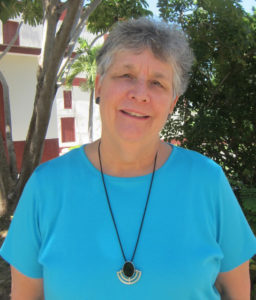 Dr. Mary E. Hunt As theologian Dr. Mary E. Hunt pointed out in a May 2013 article in the National Catholic Reporter, “Courage is an old-fashioned virtue that comes in many forms: physical, social and political. I have paid attention to it of late—both in its absence and presence—in the hope that highlighting courage will make it multiply. A dose of courage would go a long way toward solving many ecclesial and civil problems.”
“I ponder how or if one can compel another to act courageously. Do we have the right to expect mere human beings will surmount self-interest and act for the common good? I am not naïve about how complicated many decisions are –weighing competing goods, preventing bad outcomes, limiting damage, and all the other complexities that make up a moral calculus. But I do know that courage needs to come back into fashion in a big way.”
My favorite story of courage is about my friends, Leah Vader and Lynne Huskinson, a lesbian couple living in Wyoming. In 2006 they married in Canada, and sent a letter to their state legislator several months later decrying a state bill that would deny recognition of same-sex marriages. The lawmaker read their letter on the floor of the Legislature. Soon after, a local newspaper interviewed the couple on Ash Wednesday, and ran a story and photo of them with ash on their foreheads, a mark of their faith.
Not long after that the couple received a letter from their pastor, the Rev. Cliff Jacobson: “It is with a heavy heart, in obedience to the instruction of Bishop David Ricken, that I must inform you that, because of your union and your public advocacy of same-sex unions, that you are unable to receive Communion.” The letter shocked Leah, who received communion every week until forbidden by Rev, Jacobson’s letter. “This is all the food we need,” she said.
The bishop said the couple’s sex life constitutes a grave sin, “and the fact that it became so public, that was their choice.” “If all this stuff hadn’t hit the newspaper, it wouldn’t have been any different than before—nobody would have known about it,” said Fr. Jacobson. “The sin is one thing. It’s a very different thing to go public with that sin.” “We’re not the bedroom police,” he said. “That ultimately comes between the person and God, but it puts it in a much different light with a public nature.”
 Lynne Huskinson and Leah Vader The couple never made any secret of their relationship. In front of their home were statuettes of two kissing Dutch girls. The couple posed for a family photo with Vader’s children from a previous marriage for the church directory and the church has sent mail to both of them at the same address for years. Huskinson questioned why Catholics having premarital sex and using birth control are not barred from receiving communion, too. Fr. Jacobson said the difference was other Catholics are “not going around broadcasting, ‘Hey I’m having sex outside of marriage” or “I’m using birth control.” But, they do. How many 8, 9, 10, 12 children families have you seen at church lately?
Courage comes in many forms and takes many faces. It took a great deal of courage for many women to write a letter to CCL’s post office box with their real name and address in hopes of making contact.
“I am a 50 year old woman, divorced, mother of two grown children (with whom I have close loving relationships), administrative officer in a human services agency, a lay pastoral minister for the –- Diocese, and an Oblate of the —. I feel I am a well balanced person who has a variety of interests, gets along well with people, and who is striving to live a peaceful and loving life. The glitch is that I am a “closet” Lesbian. I feel certain there are other people in the world, who are like me—who want to live wholesome, full lives, and are persons of faith. I would like to connect with a group or some individuals with whom I could share companionship, support, and be able to be open, authentic, and find acceptance.”
I don’t remember what happened to this particular woman, but I hope we were able to direct her to an area contact or group that would welcome her. It is very hard, impossible, I think, to be courageous alone. You need a group, or support network, or a lover to help inspire and give you strength.
There were other women who—for very good and prudent reasons—could not be public but sent expressions of support. I wrote to one woman about joining us at the gay pride day parade in New York City and received this reply:
“Right now I can’t afford any publicity even though I back the cause 100%,” the letter began. “I am a teacher in a Catholic elementary school in New Jersey. It is the only job I have now and cannot afford to put the job in jeopardy. I lived with someone for 7 ½ years who died about a year and a half ago. We were very much in love with each other and I am still grieving over her loss. Ethel was sick for many years before she died since she was a diabetic and has left many medical bills behind that I am still paying for. The pieces of my life have shattered since her death and I am still trying to put them back together. There is not much of a support system for a lesbian losing her lover. It has been a long hard road for me and sometimes I feel I can never recover, the pain can be so great. Because of my job and financial commitments I have to repay money for Ethel’s care I cannot come “out of the closet.” However, if I could be of any service to CCL in a behind the scenes capacity I would be more than willing to do what I can. I hope you can understand my predicament. If there is any way I can be of service please don’t hesitate to let me know.”
When I put the letter down, paused and closed my eyes to think about her, a quote from Helen Keller came to mind: “I long to accomplish a great and noble task, but it is my chief duty to accomplish humble tasks as though they were great and noble. The world is moved along, not only by the mighty shoves of its heroes, but also by the aggregate of the tiny pushes of each honest worker.” This woman had performed a great and noble task by her loving care and responsibility for Ethel. I’d like to think that this devotion has been recognized by Ethel’s medical practitioners, neighbors, friends and families.
Courageous acts of big shoves and little pushes help to change the church. We need to encourage them. I have fallen short on courage many times: the remarks and jokes I have let go by; the countless calculations of whom to trust, how much to disclose, what to risk, opinions suppressed, comments reined in; interests concealed. After each time I have kept silent or didn’t speak out, I pick myself up and resolve to do better. I also pray that if I am called to risk much by identifying clearly who I am, whom I love and what I believe, that I will conduct myself with the same grace and bravery, as Leah Vader, Lynne Huskinson and Dr. Mary Hunt.
There is a lot of anger and sadness present in Catholic lesbians and gay men when it comes to our church. Our sexual orientation had to be kept bottled up and silent if we wanted to continue to belong to our families and church. This inability to talk about our attractions and that part of us produced terrible conflict and pain. Our need to matter and our need to belong are as fundamental as our need to eat and drink. Ostracism—rejection, silence, exclusion—is one of the most powerful punishments that can be inflicted. Many of us left the church at that point, with a bitterness that came from feeling betrayed at our deepest core. When we needed kindness and understanding the most, our church utterly failed us. 
There is some improvement in the atmosphere today, with dedicated parish ministries, people and clergy of good will who are warm and welcoming. Official church teaching now calls for tolerance and acceptance, but church practice frequently belies this. Countless stories continue to be recorded of lesbian and gay Catholics who are fired from parish or diocesan jobs simply for going public that they live in a same-sex relationship; couples who are booted out of pastoral ministries because they are married; and gay parents who have to constantly hear statements from church hierarchy that we are morally unfit to adopt or raise children. The church hierarchy continues to lead the charge that same-sex marriage will destroy the family, even civilization.
What is most laughable about this farce is that these statements are coming from mouths that have yet to publicly chastise and remove a brother bishop for protecting predator colleagues or priests at the expense of vulnerable children and young people. Gay men in the church have to deal with homophobia but Catholic lesbians have a double whammy: the issue of homosexuality, and the complete marginalization of ourselves as women.
In her testimony at a public hearing sponsored by the Boston Women’s Ordination Conference, in spring 1980, Dr. Lorna Hochstein addressed the topic, “Woman and Roman Catholic: Is it Possible?” What she said was:
“No: it’s not possible to be a woman and a Roman Catholic. And yet I am. Somehow I am. I am because I was born a Catholic, because I was raised a Catholic, because I think in Catholic categories and speak in Catholic vocabulary. I am a Catholic because I miss that church’s rituals when I’m without them, and because a cross hung with a body speaks infinitely more to me than one without the body. I am Catholic because my heart and soul want to be Catholic. I’m a Catholic one day at a time, one week at a time, and I’m a Catholic with varying degrees of intensity. Each time I go to a liturgy, I make a deliberate choice. Each time I say “Yes, I am a Catholic,” it is because on that day I can somehow believe that I am whole, valuable, and complete person who is also a woman; and on that day I am able to be such a woman in a church which denies me recognition of my full humanity by saying I am not able, that I am not adequate, to represent the humanity of Christ.”
“I am a human being, a female human being, before I am Catholic. I am a female human being called by God to minister to others as fully as I am able, and because of this, I live as a witness to the sinfulness of my church, the church that presumes to know what it is that God wants for me. More than that, it presumes to know what God wants and doesn’t want for every single Catholic woman in the world. Before I was born, my church knew that God would never call me or any other woman to be a priest, deacon or altar server. Before any woman is born, the hierarchy of my church knows that “God the Father” will be enough for each and every one of us. How can they presume so much?”
“Today I am a Catholic. Tonight as I speak, I am a Catholic. But I am a woman first, and as such, I live on the boundary of that institution, with one foot already outside. So I manage to keep my own self whole. I keep my sanity and live with this contradiction. Today I am a Catholic. But tomorrow I might leave.”
In the 41 years since those words were spoken one thing changed: we now have female altar servers in many parishes. An overwhelming majority of people who identify themselves as Catholic support women’s ordination. They also support same-sex marriage in a higher proportion than the U.S. population as a whole. Then why does the institutional church remain so resistant to even talking about change?”
Next: Finding Our Place as Catholic Lesbians: Chapter 3 – Courage
 Kirkridge An unmet need for connection, support and affirmation was the spark behind the Conference for Catholic Lesbians (CCL) held at Kirkridge Retreat Center in November 1982. At that time, no Catholic women’s or gay organization spoke sensitively to the needs of Catholic lesbians, or in many cases, even acknowledged our existence at all. Except for a small presence in Dignity, we were invisible and voiceless.
The goal of the first conference was to come together with others who identified as Catholic and as lesbian; but also to articulate how these two identifications were often at odds in our church, in the gay and lesbian community, and in us. To be one, we had to hide the other. This lack of authenticity and wholeness affected every part of our lives and spirituality.
The conference organizers asked the participants what they hoped to get out of the conference. Among the major themes were the following:
-A greater understanding of myself as a Catholic lesbian; establish friendships with other lesbian women who treasure and nurture their spiritual selves; support and direction.
-A renewal of my Catholic faith and a way to combine it with my lesbianism to a workable balance.
-Prayer & community in a supportive environment. For three years I experienced those elements as a Sister of Mercy. Though it’s been five years since I left the community, the prayer, community and supportive atmosphere are still missed.
-Sharing ideas and experiences with other women of the same background and philosophy in an atmosphere of openness and acceptance. To be able to be proud of being a Catholic and a lesbian without punitive consequences.
-An answer to the question, “How can one be a sexually active lesbian and a Catholic?”
-Help toward resolving my indecision if a lesbian can be Christian, much less Catholic.
-To meet Catholic women, get a better view of women (gay) in the church and learn how to incorporate my Christian gayness in the straight world without becoming bitter.
-A sense of reassurance that Catholic lesbians have not abandoned the church; that God is an integral factor in other lesbians’ lives. An opportunity to discuss Catholicity with other lesbians.
-A greater appreciation of my place in the gay community as a deeply committed Christian woman.
-Meet new people, gain new insight, broaden my thinking and have fun.
-The opportunity to meet and talk with other Catholic lesbians. To share feelings/common problems. To be quite honest, just to be able to do something as a group of Catholic lesbians to come away with a feeling of belonging. That there really are more Catholic lesbians out there than the 1 or 2 we see at church occasionally.
 Kirkridge vista What emerged from that weekend gathering was the realization that although there are many ways to identify as being Catholic or lesbian, we shared a bond to a faith with which we would always feel connected, even if we ceased to consider ourselves practicing church members.
What was special about Kirkridge and subsequent conferences was the opportunity to meet, hear and speak with other Catholic lesbians about shared gay experiences, especially the pain that often comes from a sense of rejection and exclusion. As one participated noted, “It is very rare to find lesbians who will own the fact that they have been/are part of the Catholic church. I hope to gain knowledge of other women’s experiences in order to share the past, and deal with the present with a new vision.”
Next: Chapter 2 – Anger and Sadness
Read the entire article here.The Importance of Being Who We Are3
 Coral Browne (July 23, 1913-May 29, 1991) was an accomplished stage and screen actress. She was also actor Vincent Price’s third wife. She was a woman who enjoyed a varied and robust sexual life. Browne portrayed no-nonsense BBC-executive, Mercy Croft, in The Killing of Sister George, a film depicting a lesbian love-triangle. She is perfect as a smooth, predatory seductress—a role in which she had plenty of experience. Coral Browne (July 23, 1913-May 29, 1991) was an accomplished stage and screen actress. She was also actor Vincent Price’s third wife. She was a woman who enjoyed a varied and robust sexual life. Browne portrayed no-nonsense BBC-executive, Mercy Croft, in The Killing of Sister George, a film depicting a lesbian love-triangle. She is perfect as a smooth, predatory seductress—a role in which she had plenty of experience.
Coral Browne converted to Catholicism shortly after World War II and remained a devout Catholic throughout her life. As a gift to her, Vincent Price converted to Catholicism. Her friend, Noel Davis, described the melding of her personality and faith: “I’m a Catholic of a sort, and I was always amused by her Catholicism because she was much more devout than fitted in with her obscenities. She never missed Mass on Sunday.” Existing the Brompton Oratory one Sunday morning, salty-tongued Browne was accosted by a theater friend with the latest gossip. She stopped him midsentence, exclaiming: “I don’t want to hear such filth, not with me standing here in a state of fucking grace.”
Browne did not get along with Vincent Price’s daughter, Victoria Price, but they both shared an interest in women. “Coral lent a sympathetic ear to my romantic troubles. Both were eager to meet anyone I brought home, though my stepmother rarely missed an opportunity to flirt outrageously with my girlfriends or to comment on their looks and style. One woman, she told me with a very knowing smile, “does it very well.” I took that as some kind of compliment.” Coral also told Victoria Price about a five-year relationship she had with a woman. Its dissolution was, according to Browne, the most heart-breaking moment of her life. 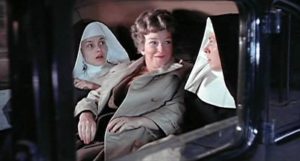
In The Killing of Sister George (1968), BBC executive Mercy Croft (Coral Browne) is sent to chastise Sister George/June Buckridge (Beryl Reid) for a drunken incident involving two nuns. Buckridge is a middle-aged soap opera actress, and Alice “Childie” McNaught (Susannah York), her lover, has a minor fashion industry job, writes poetry and collects dolls. George/June is often verbally and physically abusive to Alice, and her treatment of her becomes worse as her character is scheduled to be eliminated on the popular show. The movie was given an “X” rating because of a two-minute masturbation scene between Coral Browne (Mercy Croft) and Susannah York (Alice “Childie” McNaught). The scene was panned as cold and unsexy—probably because they had most of their clothes on and didn’t writhe and moan continuously. But in 1968 it was revolutionary to see two mature women–McNaught was in her 30s and Croft was in her 50s–having sex to orgasm in a movie.
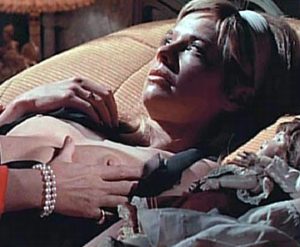
The movie was also history-making in that the director used a real lesbian bar for the lesbian club scene. Between June 9-16, 1968, The Killing of Sister George was shot at the Gateways, a lesbian club that operated in London between 1931 and 1985. Forty members were used as extras, one of whom lost her job when her employer recognized her in a publicity still. George and Alice go to an event at Gateways to which George jokingly invites Mrs. Croft. Mrs. Croft arrives to tell June in person that Sister George will die by being hit by a ten-ton lorry, eliminating her from the show. After June storms out, Mrs. Croft invites Alice to meet with her to further discuss her poetry. Alice has found a new lover/provider and June blew her chance with a woman she once desired and adored.
I wonder how Coral Browne reconciled the sexual and religious aspects of her life. She doesn’t strike me as a hypocrite and didn’t feel obligated to “leave” the Church. Browne died in 1991 without expressing a public opinion or statement; so we’ll never know her thoughts and feelings. The one aspect we do know is that she appeared to value monogamy while married. She had Vincent Price give up a male friend to whom he was strongly attached. That hurt Price deeply. It’s my one mark against Coral Browne.
How do you remain as lesbian and Catholic? My stance—perhaps Coral Browne’s—is to embrace the beautiful and positive in both and dismiss the negativity from secular skeptics and religious gatekeepers. The focus on what is most important – our relationship with God – can be difficult to achieve with all the worldly chatter and distractions; but over time we can sustain it through prayer, quiet time, meditation and the Eucharist.
Click here to see a trailer of The Killing of Sister George.
Click here to see a YouTube video of the Gateways club scene in the film.
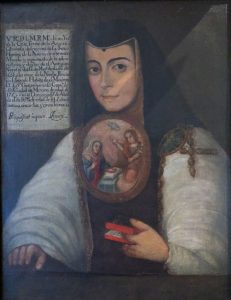
Sor Juana Ines de la Cruz (November 12, 1648 – April 17, 1695), was passionate about educational access, books, learning, equality and women. She was a 17th century nun, self-taught scholar and acclaimed writer. She was born in San Miguel Nepantla near Mexico City on November 12, 1648. Her parents were Isabel Ramirez, a Criolla (native-born Spanish) woman, and Captain Pedro Manuel de Asbaje of Spain. They didn’t marry. Juana lived a comfortable life on the estate of her maternal grandfather. She educated herself in her grandfather’s library. Juana was a high-spirited girl who loved learning and the life of the mind. She was also very beautiful to which her portraits will attest. She was fluent in Spanish, Nahuatl and Latin.
When she was 16 she asked for her parents’ permission to disguise herself as a youth to attend the university, which did not accept women. Her family sent her to court to meet influential people and find a husband. Instead, in 1669, she entered the monastery of the Hieronymite nuns. She choose to become a nun “to have no fixed occupation which might curtail my freedom to study.”
As a nun, she was free to study the 4,000 books she collected, mostly from her grandfather’s library. Her cell became a salon for the intellectual elite. She gained the patronage of the viceroy, Marquis de la Laguna, and the vicereine of New Spain, Countess Maria Luisa de Paredes. They supported and protected her, and had her works published in Spain. The two women became passionate friends. Whether or not a physical relationship existed isn’t clear, but love and desire definitely existed. In her poem, “My Lady” Sor Juana Inez describes her emotions: 
“I love you with so much passion, neither rudeness nor neglect can explain why I tied my tongue, yet left my heart unchecked.
The matter for me was simple; love for you was so strong, I could see you in my soul and talk to you all day long.
How unwisely my ardent love, which your glorious sun inflamed, sought to feed upon your brightness, though the risk of your fire was plain!
Let my love be ever doomed if guilty in its intent, for loving you is a crime of which I will never repent.”
Sor Juana’s sermons, which were transcribed and widely circulated, paid unusual attention to gender imagery. She said that she had been conceived as a male but was changed in utero by God to become female. She delighted in Jesus’ self-reference as a mother hen and spoke of the male and female aspects of God. She believed this mixture of identities also resided in the human soul:
“And all those who seek in me a father,” she wrote, “will find me a father. And those who seek in me a mother, will find in me a mother. And those who seek in me a husband, will find in me a husband. And those who seek in me a bride, will find a bride. And those who seek in me a brother, or a friend, or a neighbor, or a companion, likewise will find in me everything they desire.”
In 1692, Church authorities cracked down on Sr. Juana, not because of gossip or lesbian love poetry, but because she openly challenged societal and ecclesiastical values and norms on women. In her most famous work “Respuesta a Sor Filotea” she defends women’s rights to educational access and opportunity to serve as intellectual authorities. Sor Juana argued that women could educate other women.
Threatened by the Inquisition, Sor Juana was silenced for the final three years of her life. There are documents showing her agreeing to undergo penance. One such document is signed, “Yo, la Peor de Todas” (I, the Worst of all Women”). Her books, scientific and musical instruments were confiscated and sold. Sor Juana died three years later nursing her sister nuns during a cholera epidemic. She was 46. Sor Juana is buried in the site of her former convent, San Jeronimo, at the University of the Cloister of Sor Juana in Mexico City.
Sor Juana lay in oblivion for several hundred years until Phoenix-like she sprang into life. Two of the sparks were books and research done by writers Octavio Paz of Mexico and Dorothy Schons of the University of Texas. 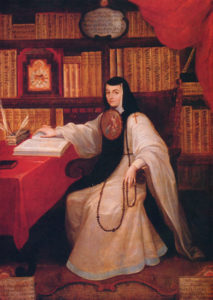
The relationship between Sor Juana and Countess Maria Luisa is explored in “Sor Juana’s Second Dream” a book published in 1999 by Dr. Alicia Gaspar de Alba. She also writes about Sor Juana in “(Un)framing the Bad Woman: Sor Juana, Malinche, Coyolxauqui and Other Rebels with a Cause,” published in 2014. A series of photos inspired by Sor Juana’s life and passions was created by Alma Lopez in 2019. Gaspar de Alba and Lopez, married to each other since 2008, have also explored lesbian connections with Our Lady of Guadalupe.
Maria Luisa Bemberg, one of Latin America’s foremost female directors, imagines the love between Juana and Maria Luisa in the 1990 film, “I, the Worst of All.” The film was Argentina’s entry for Best Foreign Language Film that year.
How far did the passions of Sor Juana go? My feeling is that she had an unbridled imagination, a tormented yearning and a chaste life. I’m sure she shared some tender, passionate, embraces with Maria Luisa, but a lack of time, privacy and mutual restraint kept a lid on any other expressions. But what a kiss it must have been!
“Then Stephen took Angela into her arms and she kissed her full on the lips.” That sentence has thrilled tens of thousands of lesbian readers, including me, to finally see, feel, imagine their desire in print. When British novelist Radclyffe Hall (1880-1943) published The Well of Loneliness in 1928, it was the first widely read novel to feature lesbian love. A British court judged the book obscene because of the words “and that night they were not divided.” 
It tells the story of Stephen Gordon, a woman given a man’s name by parents that wanted a boy, who is irresistibly drawn to other women. She was born on Christmas Eve and named after the first Christian martyr. As a girl she had a dream: “that in some queer way she was Jesus.” Seven-year-old Stephen develops a crush on the Gordon’s maid, Collins. When she discovers that Collins has “housemaid’s knee” she prays that the affliction be transferred to her. “I would like to wash Collins in my blood, Lord Jesus—I would very much like to be a Saviour to Collins—I love her, and I want to be hurt like You were.” Stephen is later devastated when she catches Collins sharing a kiss with the footman.
As a young woman Gordon has an affair when a neighbor’s wife. After a confrontation with her mother about her “unnatural” love, she retreats to her father’s study and discovers a book by German psychiatrist, Krafft-Ebing, on deviant sexuality. After she reads it, she understands what she is—a female “invert,” a lesbian. She opens a Bible, and seeking a sign, reads Genesis 4:15: “And the Lord set a mark upon Cain…” Radclyffe Hall used the mark of Cain, a sign of crime and exile, throughout the book for the status of “inverts.”
Stephen meets Mary Llewellyn, the love of her life, in France during World War I. The two set out to build a life together, but Stephen believes that Mary’s life is suffering because as a couple they are an object of scorn and contempt. To “save” her, she feigns an affair with another woman to drive Mary into the arms of a man who admires and wants her. Mary leaves her and marries. Stephen is devastated and alone. She has a vision of being thronged by millions of inverts from throughout time, living, dead and unborn. They beg her to speak with God for them. Possessing her, she articulates their collective prayer: “God,” she grasped. “We believe, we have told You we believe…We have not denied You, then rise up and defend us. Acknowledge us, oh God, before the whole world. Give us also the right to our existence!”
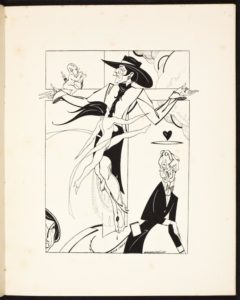
Radclyffe Hall was a pioneer in her efforts to reconcile Christianity and homosexuality. Her defense of gay men and lesbians took the form of a religious argument: if God created inverts, the rest of humanity should accept them. Declaring homosexuality to be a “part of nature, in harmony with it, rather than against it.” She posed the question to her attackers: “if it occurs in and is a part of nature, how can it be unnatural?” She also knew the price that gay and lesbian people pay to remain in the closet and railed against the “conspiracy of silence” saying, “Nothing is so spiritually degrading or so undermining of one’s morale as living a lie.” 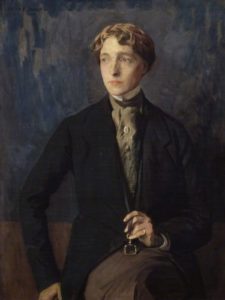
The controversy over The Well of Loneliness was lampooned in The Sink of Solitude, a satirical pamphlet by Beresford Egan, novelist, and illustrator. One drawing shows an immediately recognizable Radclyffe Hall with her trademark Spanish riding hat nailed to a cross. A near-nude Sappho leaps in front of the martyred “St. Stephen” and Cupid perches on the crossbeam. While Egan agreed with Hall’s arguments, he spoofed her piety and moralizing.
Radclyffe Hall is like many Catholic lesbians I have met: conventional, judgmental, spiritual, and often promiscuous.
She was born Marguerite Radclyffe on August 12, 1880 at Christchurch, Bournemouth, England. In later life she was called John by her friends and lovers, and M. Radclyffe Hall or Radclyffe Hall in her books. Her mother, Marie, was an American and her father, Radclyffe Radclyffe Hall, was English. Her parents divorced when she was two and Marie remarried a musician, Albert Visetti. The young girl never liked him. She reached young womanhood without much education or interests except chasing women. Her specialty seems to be the seduction of married women.
In 1907, at 27, unattached and drifting, Hall made a trip to Bad Homburg, Germany, known for its wellness spas and baths. She became smitten with Mabel (Ladye) Batten, a renowned beauty and amateur singer. Batten’s portraits were painted by John Singer Sargent and Edward John Poynter. The 50-year-old married grandmother had ties to aristocratic society and was rumored to have had an affair with King Edward VII. The poet-adventurer Wilfrid Scawen Blunt was an admirer. Witty, elegant, cultured, beautiful and worldly, Batten was everything Hall desired. They became lovers and stayed together until Batten’s death in 1915. 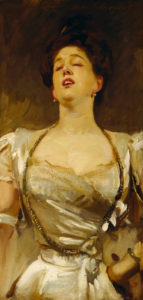
Batten was a major influence on Hall, and encouraged her to write poetry. Hall’s first book of poems, A Sheaf of Verses, published in 1908, reveals her first, tentative references to homosexuality. A second book of poetry including the “Ode to Sapho” was published later that year. Her third volume came out a year later. When Batten’s husband died in 1910, the two women made a home together. Hall’s fourth poetry anthology was dedicated to Batten.
Batten was politically conservative, and Hall adopted her positions. Ladye was also a Catholic convert, and under her encouragement and influence, Radclyffe Hall was received into the Catholic church on February 5, 1912. She was 32. Her baptismal name was Antonia, and she chose Anthony as her patron saint. Hall and Batten worshiped together at London’s fashionable Church of the Immaculate Heart of Mary, known as the Brompton Oratory. In 1913, Hall and Batten made a pilgrimage to the Vatican. They went to Mass at St. Peter’s Basilica. Pope Pius X blessed them in a semi-private audience with other substantial donors. They returned to London with religious-themed triptychs, gilt angels and an alabaster Madonna.
The refined Ladye was both a maternal and wifely figure for Radclyffe Hall. The once-feminine Hall, who wore skirts all her life and only had her waist length blond hair cut in her 30s, started to cultivate a more masculine appearance, close-cropped hair, tailored jackets and bow-ties. Batten gave Hall the nickname “John” after noting her resemblance to one of Hall’s male ancestors. She used this name for the rest of her life. Was Hall butchy, a butch, stone butch, or these days – a transman? It’s hard to say. She said that she had a man’s soul in her body.
In 1915, 35-year-old Radclyffe Hall met Una Troubridge (1887-1963), a 28-year-old cousin of Mabel Batten, at a tea party in London. They were immediately sexually attracted to one another and began an affair. Their relationship that would last until Hall’s death in 1943. Troubridge was a sculptor and mother of a young daughter. She was married to Vice-Admiral Ernest Troubridge, a career naval officer who was 25 years her senior. Hall’s affair with Troubridge caused an uneasy situation among the three women. 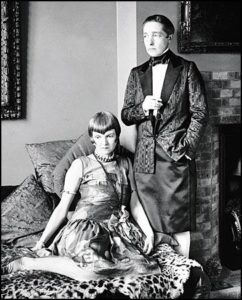
In May 1916, Batten suffered a cerebral hemorrhage after a quarrel with Hall over Troubridge. She died ten days later. Guilty and grief-stricken, Hall believed her infidelity had hastened Batten’s end. She had Batten’s body embalmed and buried her with a silver crucifix blessed by Pope Pius X. Soon after Batten’s death, Hall and Troubridge developed an interest in spiritualism and began attending seances with a medium, Mrs. Gladys Osborne Leonard. They believed Batten’s spirit gave them advice.
Most of the stories, poems and novels Radclyffe Hall wrote touched on Christian themes, Catholic imagery, lesbian desire or all three. In 1924, Radclyffe published The Forge, a fictionalized portrait of American lesbian artist Romaine Brooks, and The Unlit Lamp, a novel about a girl who dreams of going to college and setting up a “Boston marriage” with her tutor, Elizabeth. A Saturday Life (1925) follows the life of a girl who takes up and discards many artistic pursuits with the support of an older woman who is in love with the girl’s mother. Hall’s fourth novel, Adam’s Breed (1926) centered on the spiritual struggles of a young man over excess consumption by modern society. He becomes disgusted with his job as a waiter and even with food itself, gives away his belongings and lives as a hermit in the forest. The story also reflect’s Hall’s concern about the plight of animals. The book won the 1926 James Tait Black Memorial Prize for fiction and the Femina Vie Heureuse Prize for best English novel.
In early July 1926 Hall completed the short story, “Miss Ogilvy Finds Herself,” which dealt with homosexuality. Later than month she began writing Stephen, the novel that became The Well of Loneliness (1928). The Master of the House (1932) is an adaptation of the Christ story in a contemporary setting. Christophe Benedict, the main character, is a deeply spiritual and compassionate carpenter who lives in Provence, France. He is born to a carpenter named Jouse and his wife, Marie. Christophe ends up being crucified by Turks in Palestine during World War I. Writing the book was so spiritually intense that Hall developed stigmata on the palms of her hands.
In the 1930s Hall and Troubridge made their home in Rye, a village in East Sussex where many writers lived. Hall used Rye as the setting for the book, The Sixth Beatitude (1936), her last novel. It is the story of Hannah Bullen, a strong-bodied young woman. Hannah Bullen’s unconventional life (unmarried mother of two children) is beset by poverty and strife within her family. Hall uses the sixth Beatitude to portray Bullen’s purity of heart and mind by sticking with them. An independently wealthy heiress, Hall gave generously to the local church. Saint Anthony of Padua was constructing a new building when they moved to Rye. Biographer Diana Souhami wrote that Hall “poured money into the church” to bring it to completion and furnish it. “She paid for its roof, pews, outstanding debts, paintings of the Stations of the Cross and a rood screen of Christ the King. A tribute to Ladye was engraved on a brass plaque set into the floor: “Of your charity, Pray for the soul of Mabel Veronica Batten, In memory of whom this rood was given.” 
What is the attraction of lesbian and gay men to Catholicism? Why did so many late 19th century writers, intellectuals, artists, clergy and bohemians (with gay lovers, tendencies or friends) take the plunge into the faith? Notable converts include Oscar Wilde, Gerard Manley Hopkins, Aubrey Beardsley, lovers Katherine Bradley and Edith Cooper, Ronald Firbank, Maurice Baring, Eric Gill, Robert Hugh Benson, John Henry Newman, Frederick Rolfe, Marc-Andre Raffalovich, John Gray; and, of course, Mabel Batten, Radclyffe Hall and Una Troubridge.
Oscar Wilde opined on the attraction of the Roman Catholic Church for outre artistic figures and rebels. He said that Catholicism was “for saints and sinners,” while…” for respectable people, the Anglican Church will do.” Becoming Catholic was an act that allowed one to become both rebellious and steeped in tradition. Irish playwright and novelist Emma Donoghue observed: “Being Catholic in England meant becoming slightly foreign, aloof from the establishment; as a church it was associated with the rich and the poor, but definitely not the bourgeoisie.” For much of English society, to become Catholic was to cross society’s lines to a suspect, “other,” even deviant, religion. But the “otherness” may have been a reason behind its attractiveness.
The sensuousness and eroticism present in Catholic art and ritual have a magnetic appeal to lesbian and gay people. Beautiful men, barely covered; women with their heads thrown back in orgasmic passion—a feast for the eyes and imagination. We can appreciate symbolic and hidden meanings, the emphasis on the body, particularly the Eucharist, where we take the body of Christ into our mouth; and the mystery inherent in ourselves and in the spiritual world. 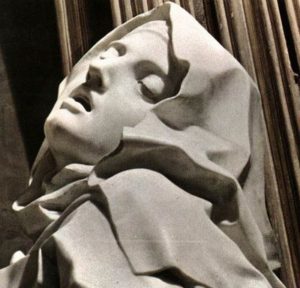
Modern scholars have explored the role of religion in Radclyffe Hall’s work. Catholic Figures, Queer Narratives (2007) includes the chapter “The Well of Loneliness and the Catholic Rhetoric of Sexual Dissidence” by Richard Dellamora. He explores Hall’s life and work. Ed Madden, English professor at the University of South Carolina, examines Hall’s use of Christ’s imagery and symbolism in Reclaiming the Sacred: The Bible in Gay and Lesbian Culture (2003) edited by Raymond-Jean Frontain.
Like a bee sipping nectar from flower to flower, Hall’s desire for women never waned. Her indiscretions as “man of the house” could be overlooked as long as they were brief. Una Troubridge and Radclyffe Hall stayed together as a couple until Hall’s death in London from colon cancer in 1943. The relationship survived Hall’s numerous flirtations and Hall’s last torrid affair with her 28-year-old White Russian nurse, Evguenia Souline (1906?-1958). Souline was hired to help care for Hall during an illness, and their relationship blossomed into much more. Despite the initial protests of Troubridge, the three women lived together in Florence, Italy. At the outbreak of World War II they left and settled in Devon, England. “Darling—I wonder if you realize how much I am counting on your coming to England,” Hall wrote to Souline, “how much it means to me—it means all the world, and indeed my body shall be all, all yours, as yours will be all, all mine, beloved. And we two will lie close in each others arms, close, close, always trying to lie even closer, and I will kiss your mouth and your eyes and your breasts—I will kiss your body all over—And you shall kiss me back again many times as you kissed me when we were in Paris. And nothing will matter but just we two, we two longing loves at last come together. I wake up in the night & think of these things & then I can’t sleep for my longing, Soulina.” Una Troubridge cannot have been happy reading that note. Even so, much of Hall’s correspondence to Evgenia Souline has been preserved. Troubridge burned Souline’s letters to Hall.
Radclyffe Hall died at her flat in Pimlico on October 7, 1943. She bequeathed her entire estate to Troubridge. At her request, she was buried in a vault next to Mabel Batten in Highgate Cemetery in London. Souline was given a small allowance and disappears from the story. At the time of her death, The Well of Loneliness had been translated into 14 languages and was selling more than 100,000 copies a year. It has never gone out of print. For decades, it was the only lesbian book generally available. 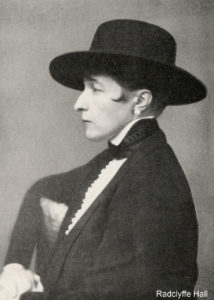
Troubridge, now a wealthy woman, moved to Italy and died of cancer in Rome in September 1963, at age 76. Shortly before Troubridge died, a woman asked her how she and Hall reconciled their relationship with their Catholic faith. What did they do about confession? Troubridge answered, “There was nothing to confess.” Troubridge left written instructions that her coffin be placed in the vault in Highgate Cemetery where Hall and Batten had been buried, but the instructions were discovered too late. She was buried in the English Cemetery in Rome, and on her coffin was inscribed, “Una Vincenzo Troubridge, the friend of Radclyffe Hall.” Years later her tomb was removed and her remains were lost.
The Well of Loneliness has been criticized by lesbians for its stereotypical butch-femme coupling, energetic lesbians who are always masculine looking, and requisite unhappy ending of a love affair or relationship between two women. What is totally ignored is Hall’s Christianity and Catholic faith in her life and writing. A friend once observed to me that it is easier to be a lesbian in the Catholic Church than a Catholic in the lesbian community. Like 19th and 20th century biographers who often left out, or slyly alluded to their subject’s homosexual life; too many “herstory” archivists, writers and editors deliberately omit lesbian religious faith and commitment. This bigotry needs to stop.
“Who are you to deny our right to love” – Radclyffe Hall The Well of Loneliness
|























